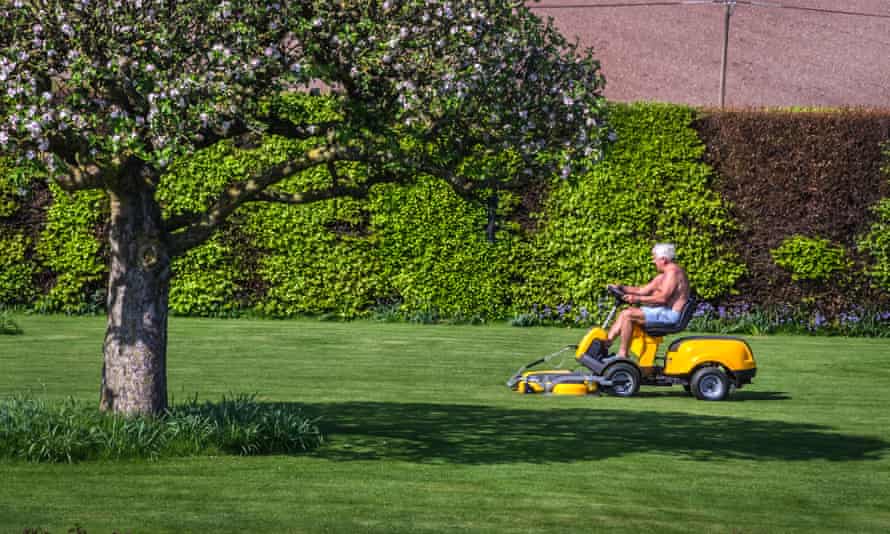Do you have a glossy green front lawn? What is this, the 1950s?
Green lawns are terrible for the environment. They’re also embarrassingly old-fashioned and out of style

Americans love front yards with big, carefully manicured lawns. In fact, homeowners spent a record $47.8bn in lawn and garden retail purchases in 2018 alone. Then there’s the water usage: 9tn gallons a year nationwide just on gardening. We consume this water even as parts of the American west are in the grip of a horrific drought that has paralyzed farmers, triggered huge wildfires, and has some states considering water cutbacks.
The reason we spend so much time, money and natural resources on our lawns, as Kristen Radtke recently noted in the Los Angeles Times, is that decades of television and popular culture have cemented in our brains a certain image of the American dream: house in the suburbs, white picket fence, two-car garage, glossy green lawn. The problem isn’t just that that image is difficult to attain for a lot of Americans. It’s that it’s embarrassingly dated.
No one at the cutting edge of gardening still thinks that a green grass lawn is the grail – especially if you live in an area like Arizona or Utah where there’s barely enough water to go around. The most forward-thinking gardeners and landscape designers are more interested in designing yards and gardens that are symbiotic with their climates.
These days, bloggers and influencers in the gardening world are loudly eschewing the water-wasteful green lawn, while showing off their decidedly less tidy landscapes. Rather than a picture-perfect garden, it’s all about planting native species, storing rainwater and finding natural alternatives for when pests and diseases strike.
So if our conceptions of gardening are outdated and effectively killing the planet, what’s the solution? Experts will tell you that the answer lies in merging garden design with ecological function – thinking intentionally about how the different parts of a landscape interact with each other, and how to create the most sustainable system for those parts. And as the obsession with perfect green lawns continues to wane, there’s no shortage of guidance on how you can create and maintain your own eco-friendly garden.
These ideas on sustainability also apply to bigger terrains, according to Carol Franklin, a pioneering landscape architect who since 1975 has advocated for the adoption of “ecological landscaping”. She sees this shift away from convention as crucial to our work of slowing down the inevitable effects of the climate crisis. In her foreword to the book The Principles of Ecological Landscape Design by Travis Beck, Franklin says that “ecological design, and in particular ecological planting design, is finally being understood as a critical tool for our ultimate survival”.
To some, ecological landscaping might feel like we’re surrendering a much-loved feature of the Americana aesthetic. But as Darrel Morrison, a legendary landscape architect who has been practicing and teaching it for decades, told the New York Times, this isn’t as much a sacrifice as it is a new – and better – approach to an old way of being.
“A lot of people, when they hear a phrase like ‘ecologically sound landscaping’, they think they are giving up something,” he said. “But they are not – it only enhances the experience.” For Morris, any good landscape design must be environmentally sound, experientially rich and dynamic, and must include species native to that specific environment.

New York City’s High Line is one large-scale example, with environmental sustainability proudly named as its core value. Essentially a green roof on top of a former railroad track that sits three stories above street level, the structure uses drip irrigation to allow its planting beds to retain as much water as possible, and features a plant selection that favors “native, drought-tolerant, and low-maintenance species, cutting down on the resources that go into the landscape”, according to its website. The High Line’s ecosystem also provides shelter to native bees, while avoiding pesticides and chemical fertilizers. Staff compost all garden waste on site.
Despite its environmental benefits, however, the presence of this space has come at a cost to the communities around it. Studies have shown that increasing the amount of green space in an area can lead to “rising property values, displacement of existing residents, and a large in-migration of wealthy populations”. Since the High Line was built, the immediate area has experienced a 35.3% increase in housing values.
Many urbanites have also questioned the practicality of essentially forcing these kinds of spaces into urban cityscapes. But it would appear that the High Line has worked well in part because of the supposed incongruity with the bustling concrete jungle just a few feet below it.
“The High Line functions as a strolling Manhattan looking glass just as much as it does as a destination unto itself,” writes the landscape architect and environmental scientist Brandon List. “That combination of contemporary urban design and unique visitor experience is what draws people, to the tune of 5 million annual visitors,” to “a neighborhood once better known for meatpacking than a world-class park”.
So is there an ethical way to put this ethos into practice in urban environments? Practicing ecological landscaping on an individual level would seem to be the answer. This would mean planting native, drought-resistant species, avoiding pesticides and chemical fertilizers, and backyard composting.
And with “wild” gardens becoming more popular these days, there may just be some hope for the future of sustainability in the ways we nurture our green spaces.
-
Tayo Bero is a freelance journalist